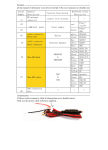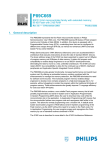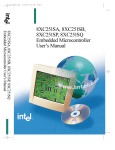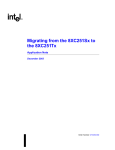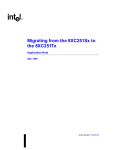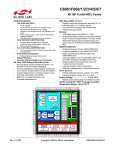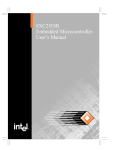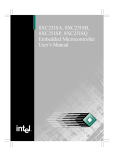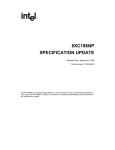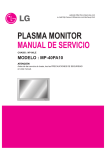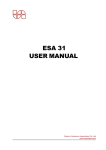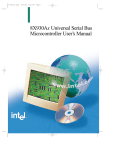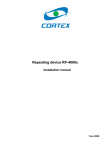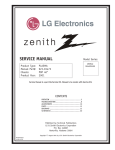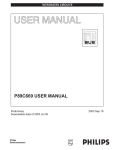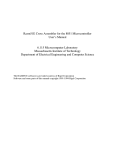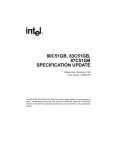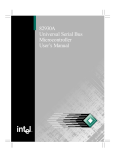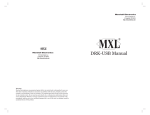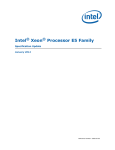Download 8XC251Sx (8XC251SA, SB, SP, SQ) SPECIFICATION UPDATE
Transcript
8XC251Sx (8XC251SA, SB, SP, SQ) SPECIFICATION UPDATE Release Date: December, 1998 Order Number: 272836-007 Notice: The 8XC251Sx may contain design defects or errors known as errata. Characterized errata that may cause the 8XC251Sx’s behavior to deviate from published specifications are documented in this specification update. Information in this document is provided in connection with Intel products. No license, express or implied, by estoppel or otherwise, to any intellectual property rights is granted by this document. Except as provided in Intel’s Terms and Conditions of Sale for such products, Intel assumes no liability whatsoever, and Intel disclaims any express or implied warranty, relating to sale and/or use of Intel products including liability or warranties relating to fitness for a particular purpose, merchantability, or infringement of any patent, copyright or other intellectual property right. Intel products are not intended for use in medical, life saving, or life sustaining applications. Intel may make changes to specifications and product descriptions at any time, without notice. Designers must not rely on the absence or characteristics of any features or instructions marked "reserved" or "undefined." Intel reserves these for future definition and shall have no responsibility whatsoever for conflicts or incompatibilities arising from future changes to them. The 8XC251Sx may contain design defects or errors known as errata which may cause the product to deviate from published specifications. Current characterized errata are available on request. Contact your local Intel sales office or your distributor to obtain the latest specifications and before placing your product order. Copies of documents which have an ordering number and are referenced in this document, or other Intel literature may be obtained by calling 1-800-548-4725 or by visiting Intel’s website at http://www.intel.com. Copyright © Intel Corporation, 12/8/98 *Third-party brands and names are the property of their respective owners. ii December, 1998 272836-007 8XC251 SA/SB/SP/SQ SPECIFICATION UPDATE CONTENTS REVISION HISTORY .................................................................................1 PREFACE ..................................................................................................2 SUMMARY TABLE OF CHANGES ...........................................................4 IDENTIFICATION INFORMATION ............................................................6 ERRATA .....................................................................................................7 SPECIFICATION CHANGES ...................................................................15 SPECIFICATION CLARIFICATIONS ......................................................16 DOCUMENTATION CHANGES ...............................................................20 272836-007 December, 1998 iii 8XC251 SA/SB/SP/SQ SPECIFICATION UPDATE REVISION HISTORY Rev. Date Version 07/01/96 001 08/07/96 002 09/18/96 003 07/16/97 06/04/98 09/23/98 004 005 006 12/02/98 007 272936-007 Description This is the new Specification Update document. It contains all identified errata published prior to this date. Added specification clarification, 001. Trdhz1 Timing. Modified workaround for specification clarification number 001. Trdhz1 Timing. Modified the Affected Products section for erratum9700008. Added Errata 9800009. Added Errata 9800010. Revised “Problem” text for Errata 9800010. Added Document Changes 1 to 3. December, 1998 1 of 20 8XC251 SA/SB/SP/SQ SPECIFICATION UPDATE PREFACE As of July, 1996, Intel’s Computing Enhancement Group has consolidated available historical device and documentation errata into this new document type called the Specification Update. We have endeavored to include all documented errata in the consolidation process, however, we make no representations or warranties concerning the completeness of the Specification Update. This document is an update to the specifications contained in the Affected Documents/Related Documents table below. This document is a compilation of device and documentation errata, specification clarifications and changes. It is intended for hardware system manufacturers and software developers of applications, operating systems, or tools. Information types defined in Nomenclature are consolidated into the specification update and are no longer published in other documents. This document may also contain information that was not previously published. Affected Documents/Related Documents Title 8XC251SB Embedded Microcontroller User’s Manual 8XC251SA, 8XC251SB, 8XC251SP, 8XC251SQ Embedded Microcontroller User’s Manual Introducing the MCS® 251Microcontroller - the 8XC251SB Maximizing Performance Using the MCS® 251 Microcontroller — Programming the 8XC251SB Migrating from the MCS® 51 Microcontroller to the MCS 251 Microcontroller (8XC251SB) — Software and Hardware Considerations 8XC251SA/SB/SP/SQ High Performance CHMOS Microcontroller datasheet 2 of 20 December, 1998 Order 272617 272795 272670 272671 272672 272783 272936-007 8XC251 SA/SB/SP/SQ SPECIFICATION UPDATE Nomenclature Errata are design defects or errors. These may cause the published (component, board, system) behavior to deviate from published specifications. Hardware and software designed to be used with any component, board, and system must consider all errata documented. Specification Changes are modifications to the current published specifications. These changes will be incorporated in any new release of the specification. Specification Clarifications describe a specification in greater detail or further highlight a specification’s impact to a complex design situation. These clarifications will be incorporated in any new release of the specification. Documentation Changes include typos, errors, or omissions from the current published specifications. These will be incorporated in any new release of the specification. NOTE:Errata remain in the specification update throughout the product’s lifecycle, or until a particular stepping is no longer commercially available. Under these circumstances, errata removed from the specification update are archived and available upon request. Specification changes, specification clarifications and documentation changes are removed from the specification update when the appropriate changes are made to the appropriate product specification or user documentation (datasheets, manuals, etc.). 272936-007 December, 1998 3 of 20 8XC251 SA/SB/SP/SQ SPECIFICATION UPDATE SUMMARY TABLE OF CHANGES The following table indicates the errata, specification changes, specification clarifications, or documentation changes which apply to the 8XC251 SA/SB/SP/SQ product. Intel may fix some of the errata in a future stepping of the component, and account for the other outstanding issues through documentation or specification changes as noted. This table uses the following notations: Codes Used in Summary Table Stepping X: Errata exists in the stepping indicated. Specification Change or Clarification that applies to this stepping. (No mark) or (Blank box): This erratum is fixed in listed stepping or specification change does not apply to listed stepping. Page (Page): Page location of item in this document. Status Doc: Document change or update will be implemented. Fix: This erratum is intended to be fixed in a future step of the component. Fixed: This erratum has been previously fixed. NoFix: There are no plans to fix this erratum. Eval: Plans to fix this erratum are under evaluation. Row Change bar to left of table row indicates this erratum is either new or modified from the previous version of the document. 4 of 20 December, 1998 272936-007 8XC251 SA/SB/SP/SQ SPECIFICATION UPDATE Errata Steppings A-1 B-1 C 9600001 X 9600002 X Rev. # Page Status 7 8 9600003 X 9 9600004 X 10 9600005 X X 11 9600006 9600007 X X X 12 13 9700008 9800009 X X X 13 X X 14 X 14 9800010 ERRATA Fixed Fixed Negative Flag WSB - Wait States for Memory Region 01 EJMP at Upper Boundary of Any 64K-Byte Fixed Region of Memory Short Jumps from Memory Region FF: to Fixed FE: Interrupt when CPU is Executing User Code Fix Not in FF:Region Fix Carry Flag Fix Watchdog Timer in the Idle Mode Data Memory Across 256-Byte Boundary Fix Region with INC DRK, #Short Interrupts of Three or More Priority Levels Fix Occuring at the Same Time NoFix EMAP# Function Specification Changes Rev. # Steppings # # # Page Status SPECIFICATION CHANGES None for this revision of this specification update. Specification Clarifications Rev. # 001 Steppings A-1 B-1 C X Page Status 16 Doc SPECIFICATION CLARIFICATIONS TRDHZ1 Timing. Documentation Changes Rev. # 1 2 3 272936-007 Document Revision 272895-002 272617-001 272617-001 Page Status 20 20 20 Doc Doc Doc DOCUMENTATION CHANGES Page 6-2, Figure 6-1 Page 5-2, Figure 5-1 page 9-14, Section 9.6.3.4 December, 1998 5 of 20 8XC251 SA/SB/SP/SQ SPECIFICATION UPDATE IDENTIFICATION INFORMATION Markings B-step devices are identified by the marking, Intel (R) (C) ‘94 ‘95 B. C-step devices are identified by the marking Intel (R) (C) ’94 ’95 C. 6 of 20 December, 1998 272936-007 8XC251 SA/SB/SP/SQ SPECIFICATION UPDATE ERRATA 9600001. Negative Flag PROBLEM: The Negative (N) Flag of PSW1 should be set or cleared corresponding to bit 15 of the result. Instead, it corresponds to bit 7 of the result. IMPLICATION: The affected instructions are listed below: a. SRL WRj b. SRA WRj c. WRj SLL d. INC WRj, #short e. DEC WRj, #short WORKAROUND: There are two ways to work around this erratum: 1. Follow the affected instructions listed above with an operation that will rectify the Negative (N) flag correctly. For example: SRL WRj ANL WRj, #0FFFFH SLL Wrj ANL WRj, WRj 2. b) Check bit 15 of the result vs. relying on the N flag for sign. STATUS: Fixed. Refer to Summary Table of Changes to determine the affected stepping(s). AFFECTED PRODUCTS: (OPTIONAL) All the 8xC251SB devices on A-1 stepping are affected. 272936-007 December, 1998 7 of 20 8XC251 SA/SB/SP/SQ SPECIFICATION UPDATE 9600002. WSB - Wait States for Memory Region 01 PROBLEM: The WSb bit of configuration byte CONFIG1 is intended to configure 0 or 1 wait states for all MOVX (including MOVX @DPTR and MOVX @Ri) instructions for the region 01:0000H-01:FFFFH. However, in 8XC251SB A-1 stepping devices, the MOVX @Ri uses WSa of the configuration byte CONFIG0 instead of WSb. IMPLICATION: The error affects the generating wait state by using WSb bit of configuration byte CONFIG0 during MOVX instruction at region 01:0000H to 01:FFFFH. WORKAROUND: There are two ways to work around this erratum: a. Configure both WSa and WSb bits with the same wait state if both MOVX @DPTR and MOVX @Ri instructions are used and require the same wait state. b. If it is required that WSb be configured different from WSa, then limit usage of the MOVX instruction to the MOVX @DPTR format rather than the MOVX @Ri format. STATUS: Fixed. Refer to Summary Table of Changes to determine the affected stepping(s). AFFECTED PRODUCTS: All the 8xC251SB devices on A-1 stepping are affected. 8 of 20 December, 1998 272936-007 8XC251 SA/SB/SP/SQ SPECIFICATION UPDATE 9600003. EJMP at Upper Boundary of Any 64K-Byte Region of Memory PROBLEM: The EJMP instruction is intended for extended jumps from one 64K-byte region of memory to another 64K-byte region of memory. However, when EJMP occurs at the upper boundary of any 64K-byte region of memory, the Program Counter (PC) will land in the wrong 64K-byte region of memory. Example 2-1. The code: “FEFFFD 8A00XXXX EJMP #00XXXXH” should branch to address 00XXXXh, but it branches to address region 01XXXXh instead. The operation of this instruction is shown below: PC) PC.23:16) PC) PC.15:0) <---- (PC) + 2 <---- (Addr.23:16) <---- (PC) + 2 <---- (Addr.15:0) PC = FEFFFFh PC = 00FFFFh PC = 010001h* PC = 01XXXXh * Note: Overflow occurs when incrementing the PC for the lower two bytes of destination address. The overflow has incremented the PC.23:16 and caused a deviation from the destination Addr.23:16. Instructions affected : EJMP IMPLICATION: The erratum affects the function of EJMP instruction at the upper boundary region. WORKAROUND: Avoid this instruction being used at the upper boundary of any 64K-byte memory region. STATUS: Fixed. Refer to Summary Table of Changes to determine the affected stepping(s). AFFECTED PRODUCTS: All the 8xC251SB devices on A-1 stepping are affected. 272936-007 December, 1998 9 of 20 8XC251 SA/SB/SP/SQ SPECIFICATION UPDATE 9600004. Short Jumps from Memory Region FF: to FE: PROBLEM: The short jump instruction is intended for a +127 or -128 byte jump relative to the current instruction. However, a short jump from the address in the lower boundary of region FF: will not branch to the address in upper boundary of region FE: even though the destination address is within this -128 byte range. Instead of landing at address in region FE:, it will remain at address in region FF:. Example: The code with “FEFFF0 FEFFF0 00 FF0002 FF0002 80EC ORG FEFFF0h REL_ADR: NOP ORG FF0002h SJMP REL_ADR” should branch to address FEFFF0h, but it branches to address FFFFF0h in the same region FF: instead. IMPLICATION: Instructions affected : SJMP, CJNE, DJNZ, JB, JBC, JC, JE, JG, JLE, JNB, JNC, JNE, JNZ, JSG, JSGE, JSL, JSLE, JZ Please note that there is no errata for short jumps from upper boundary of region FE: to lower boundary of region FF: ; and no errata for short jumps from upper boundary of region 00: to lower boundary of region 01: and vice-versa. WORKAROUND: Avoid these instructions being used for a short jump from the lower boundary of region FF: to the upper boundary of region FE: STATUS: Fixed. Refer to Summary Table of Changes to determine the affected stepping(s). AFFECTED PRODUCTS: All the 8xC251SB devices on A-1 stepping are affected. 10 of 20 December, 1998 272936-007 8XC251 SA/SB/SP/SQ SPECIFICATION UPDATE 9600005. Interrupt when CPU is Executing User Code Not in FF:Region PROBLEM: For 8XC251SB, the Reset Vector and Interrupt Vectors are defined at the FF: region. If there is an interrupt occurs, the CPU is not able to jump to the Interrupt Vector when the CPU is executing the user code at regions other than FF:. Example: If the user code size is 128K-Byte, the first 64K-Byte of the user code is located at FF: region and the other 64K-Byte of the user code is located at FE: region. The Reset Vector and Interrupt Vector for External Interrupt 0 (INT0) are defined at the FF: region as shown below. FF0000 02 0100 FF0003 02 0300 FF0100 12 0200 FF0300 C0D0 ORG FF:0000h LJMP MAIN ORG FF:0003h LJMP EXT_INT0 ORG FF:0100h MAIN: LCALL INITIALIZE_INT0 ORG FF:0300h EXT_INT0: PUSH PSW . . RETI When the CPU is executing user code from FE: region, if an External Interrupt (INT0) occurs, the CPU is not able to jump to Interrupt Vector (EXT_INT0) as defined at FF: region. IMPLICATION: This error affects additional interrupt vectors to be initialized at other memory regions. WORKAROUND: Bit 4 (INTR bit) of Configuration Byte (Config1) must be set to 1. All needed Interrupt Vectors must be defined at other regions (other than FF: region) as well. For an example, if the user code size is 128K-Byte and the first 64K-Byte of the user code and the Interrupt Vector for External Interrupt 0 is defined at FF: region, that is ORG FF:0003h LJMP EXT_INT0 272936-007 December, 1998 11 of 20 8XC251 SA/SB/SP/SQ SPECIFICATION UPDATE then there are two possible ways to locate the other 64K-Byte of user code and the workaround: 1. If the other 64K-Byte of user code is located at FE: region, the following instructions must be added to the user code at FE: region, ORG FE:0003h EJMP EXT_INT0 2. if the other 64K-Byte of user code is located at 00: region, the following instructions must be added to the user code at 00: region. ORG 00:0003h EJMP EXT_INT0 STATUS: Fix. Refer to Summary Table of Changes to determine the affected stepping(s). AFFECTED PRODUCTS: All the 8xC251SB A-1 and 8XC251SA/SB/SP/SQ B-1 stepping devices are affected. 9600006. Carry Flag PROBLEM: The Carry (CY) Flag of PSW and PSW1 should be set or cleared corresponding to the last bit (bit 7) shifted out from a 8-bit Register after completion of the SLL instruction. After execution of this instruction, the Carry (CY) Flag is not set or cleared corresponding to the last bit (bit 7) shifted out from a 8-bit Register. IMPLICATION: The only affected instruction is listed below: SLL Rm WORKAROUND: Avoid this instruction. STATUS: Fix. Refer to Summary Table of Changes to determine the affected stepping(s). AFFECTED PRODUCTS: All the 8xC251SA/SB/SP/SQ devices on B-1 stepping are affected. 12 of 20 December, 1998 272936-007 8XC251 SA/SB/SP/SQ SPECIFICATION UPDATE 9600007. Watchdog Timer in the Idle Mode PROBLEM: During the hardware or software WatchDog Timer operation in the Idle Mode, it should RESET the controller and wake up from the Idle Mode after the counter overflow. The controller fails to perform this operation. IMPLICATION: This error affects the usage of hardware and software watchdog timer during the idle mode. WORKAROUND: There is no workaround for this erratum. This erratum is fixed in the 8XC251SA/SB/SP/SQ next stepping (C stepping). STATUS: Fix. Refer to Summary Table of Changes to determine the affected stepping(s). AFFECTED PRODUCTS: All the 8xC251SB 8XC251SA/SB/SP/SQ B-1 stepping are affected. 9700008. devices on A-1 stepping and Data Memory Across 256-Byte Boundary Region with INC DRK, #Short PROBLEM: When the DRk register contains the address for data memory, the INC DRk, #short instructions — where short is either 1, 2 or 4 — do not work across the 256Bytes (FFH) boundary region. Example: If the content of DR4 register is 0000 00FEH, which is the address for data memory, the following instructions: INC DR4, #2H should increase the content of DR4 register, i.e., data memory address to 0000 0100H. However, the DR4 register does not contain 00000100H. IMPLICATION: This error affects the instructions INC DRk, #short. WORKAROUND: Replace INC DRk, #short with ADD DRk, #short. Example: By using the same example shown above, the workaround should be ADD DR4, #2H STATUS: Fix. Refer to Summary Table of Changes to determine the affected stepping(s). AFFECTED PRODUCTS: All 8xC251SA/SB/SP/SQ devices on B-1 and C steppings. 272936-007 December, 1998 13 of 20 8XC251 SA/SB/SP/SQ SPECIFICATION UPDATE 9800009 Interrupts of Three or More Priority Levels Occuring at the Same Time PROBLEM: When three or more interrupts of different priorities occur at approximately the same time (~40 ns window) on the 8xC251Sx, the lowest priority interrupt will not be serviced correctly. As the lower priority interrupt is interrupted by a higher priority interrupt, the interrupt pending bit remains set and the device believes it is still servicing the lowest priority interrupt. This disables any further lowest priority interrupt from being serviced. Any interrupt source can be affected by this if it is the lowest priority of the three enabled interrupts. For example, if external interrupt 0 is priority 3, timer 1 is priority 2 the and serial port is priority 0, and all three interrupts occur at the same time, then the serial port interrupt would stop being serviced. IMPLICATION: This will cause the lowest priority interrupt to no longer be serviced and the interrupt will not recover unless a device reset occurs WORKAROUND: To ensure this interrupt priority conflict does not occur, make sure only two interrupt priority levels are enabled at any given time STATUS: Fix. Refer to Summary Table of Changes to determine the affected stepping(s). 9800010 EMAP# Function PROBLEM: The EMAP# bit of the configuration byte is intended to map the upper half of the on-chip code memory (region FF:2000H - FF:3FFFH to region 00:E000H - 00:FFFFH). However, when data is retrieved from region 00:E000H - 00:FFFFH by use of the read instructions, data from incorrect addresses are retrieved. IMPLICATION: The erratum affects the function of the EMAP# bit at the upper half of on-chip code memory. WORKAROUND: There are two ways to workaround this erratum: 1. Directly read the data from region FF:2000H - FF:3FFFH by using instruction MOV A,@DR0 instead of reading from region 00:E000H - 00:FFFFH. 2. Use instruction MOVC A,@A+DPTR to directly read the data from region FF:2000H - FF:3FFFH. The limitation for this instruction is that it can only be used to read 256 bytes of data continuously. STATUS: NoFix. Refer to Summary Table of Changes to determine the affected stepping(s). AFFECTED PRODUCTS: 87C251SB,SQ and 83C251SB,SQ devices on C-Stepping are affected. 14 of 20 December, 1998 272936-007 8XC251 SA/SB/SP/SQ SPECIFICATION UPDATE SPECIFICATION CHANGES None for this revision of this specification update. 272936-007 December, 1998 15 of 20 8XC251 SA/SB/SP/SQ SPECIFICATION UPDATE SPECIFICATION CLARIFICATIONS 001. Trdhz1 Timing. PROBLEM: The TRHDZ1 (Instruction Float After RD#/PSEN# High) specification on the 8XC251Sx when operating at 12 MHz is 10 ns. However, a slow memory device such as an EPROM typically takes approximately 30 – 90 ns to float its output. (This specification generically called TPHZ, may vary from one manufacturer to another.) and illustrate the TRHDZ1 timing. The difference between the TRHDZ1 and TPHZ specifications causes contention on the data bus (P0 in nonpage page, P2 in page mode). The 8XC251Sx begins to drive the address for the next bus cycle while the memory device is still driving data from the previous bus cycle. State 1 State 2 State 1 (next cycle) ALE TLHLL RD#\PSEN# TLLRL TRLRH TAVLL TRLAZ TAVRL TRLDV TRHDX TRHDZ1 TLLAX TLHAX P0 TRHLH1 A7:0 Instruction In TAVDV1 A17/A16/P2 A17/A16/A15:8 TAVDV2 A5011-01 Figure 1. External Code Fetch, Nonpage Mode 16 of 20 December, 1998 272936-007 8XC251 SA/SB/SP/SQ SPECIFICATION UPDATE State 1 Cycle 1, Page Miss State 2 Cycle 2, Page Hit State 1 ALE TLHLL RD#\PSEN# TLLRL TRLDV TRHDX TLLAX TLHAX TRHDZ1 A15:8 Instruction 1 In TAVDV1 A17/A16/P0 † TAVLL TRLAZ TAVRL P2 TRHLH1 TRLRH Instruction 2 In TAVDV3 A17/A16/A7:0 TAVDV2 † During a sequence of page hits, PSEN# remains low until the end of the last page hit cycle. A5028-02 Figure 2. External Code Fetch, Page Mode To prevent this contention, designers can use a buffer to isolate the output of the memory device from the data bus (port 0 or port 2) of the 8XC251Sx. This will prevent the slow memory device from driving the data bus during the critical period after TRHDZ1 expires. We suggest a buffer such as the 74F541 octal, three-state line driver shown in Figure 3. 272936-007 December, 1998 17 of 20 8XC251 SA/SB/SP/SQ SPECIFICATION UPDATE AD7:0 P0.7:0 D8:1 ALE LE OE# Q8:1 A7:0 Q8:1 A7:0 74AC373 P2.7:0 74AC04 P3.6/WR# P3.7/RD#/A16 CS2# A15:8 A15:8 A16 CE# OE# A16 CS1# OE# WE# 128K RAM 128K EPROM PSEN# P1.7/CEX4 /A17/WCLK 8XC251Sx D7:0 VCC A16 PSEN# PSEN# A16 A17 A17 WR# OE2# OE1# D7:0 Y7:0 A7:1 74F541 A5111-02 Figure 3. Example Bus Contention Solution for 8XC251Sx Figure 3 illustrates the connections of an 8XC251Sx configured for nonpage mode with EPROM and RAM in external memory. If your system uses a different configuration, your circuit will be different from the example. The 74F541 is enabled to pass data from the EPROM to the 8XC251Sx (port 0) when OE1# and OE2# are active. Table 1 is a truth table for the 74F541. 18 of 20 December, 1998 272936-007 8XC251 SA/SB/SP/SQ SPECIFICATION UPDATE Table 1. Truth Table for 74F541 Inputs Outputs OE1# OE2# A7:1 Y7:1 L L L L L L H H X H X Z H X X Z During a read, PSEN# turns the buffer on (OE1# and OE2# are active), connecting the EPROM’s output to the 8XC251Sx’s port 0. When PSEN# goes high after a read, 1G# and 2G# are deasserted and the buffer’s output switches to the high-impedance state in approximately 9.5 ns (TPHZ for a typical 74F541; the value may vary from one manufacturer to another). Thus, contention on the data bus is prevented. This or a similar hardware solution is recommended for 8XC251Sx designs in which slower memory devices do not meet the TRHDZ1 timing specification. 272936-007 December, 1998 19 of 20 8XC251 SA/SB/SP/SQ SPECIFICATION UPDATE DOCUMENTATION CHANGES 1. Page 6-2, Figure 6-1 PROBLEM: Interrupt System Error: • The PCA, Serial, and Timer2 Interrupts have been wrongly placed in the diagram, according to their interrupt priority-within-level. The correct placement is after the Timer1 interrupt. The next sequence should be Serial interrupt, followed by Timer2, and then PCA interrupt. AFFECTED PRODUCTS: 8XC251SA, 8XC251SB, 8XC251SP, 8XC251SQ Embedded Microcontroller User’s Manual. 2. Page 5-2, Figure 5-1 PROBLEM: Interrupt System Error: • The PCA, Serial, and Timer2 Interrupts have been wrongly placed in the diagram, according to their interrupt priority-within-level. The correct placement is after the Timer1 interrupt. The next sequence should be Serial interrupt, followed by Timer2, and then PCA interrupt. AFFECTED PRODUCTS: 8XC251SB Embedded Microcontroller User’s Manual. 3. page 9-14, Section 9.6.3.4 PROBLEM: Serial I/O Port Error: • There is an equation to calculate the baud rate of the serial port. In the denominator, the manual wrongly states “32 X [553 - (RCAP2H,RCAP2L)]”. It should state “32 X [65536 - (RCAP2H,RCAP2L)]”. AFFECTED PRODUCTS: 8XC251SB Embedded Microcontroller User’s Manual. 20 of 20 December, 1998 272936-007
























